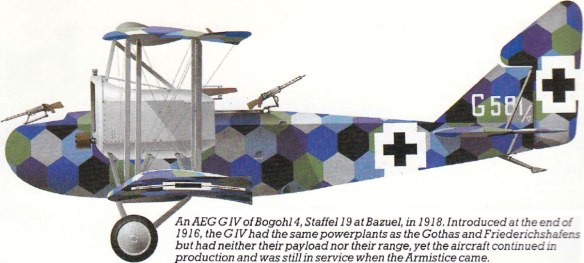AEG G.II Unit: BAO (Brieftauben Abteilung Ostende) Serial: G6/15
Crew: pilot – Oblt Georg Zeumer, observer – Lt.Manfred von Richthofen. France, September 1915. Note: profile shows Field Grau painting, but it also may be Yellow; serial number G6/15 is according A.E.Ferko ‘Richthofen’, but on the photos it more likely looks G5/15.
First appearing in mid-1915, the G. II was a bigger aircraft than the G. I and was powered by a pair of 150hp Benz Bz. III engines. Operated by a crew of three, the G. II had up three defensive machine-guns and could carry a bomb load of up to 441lbs.
Germany was the first to recognise the potential of operating bomber squadrons in large numbers over the Western Front from early 1915. Later that year A. E. G. (Allgemeine Elektricitäts-Gesellschaft) responded by constructing the G. I which was woefully underpowered and only one example was built.
The G. II followed suit with more powerful engines and the ability to carry up to 441lb of bombs. However only 15 were built before it was superseded by the G. III which continued to raise the performance bar, but once again only limited numbers were produced. By late 1916 the definitive model, the G. IV had arrived with more adequate 260hp Mercedes D. IVa inline piston engines which allowed for a fourth crew member compared to the previous aircraft’s crew of three. Each crew position was interconnected. The G. IV was capable of carrying a healthy maximum bomb of 882lb but this would be to the detriment of range and this amount was very rarely carried operationally. This restricted the G. IV to short-range tactical operations but the aircraft’s overall effectiveness was very good.
The most prolific of all the G series types, approximately 320 G. IVs were built between 1916 and 1918. Never fully superseded, a G. IVb and G. IVK variant was produced, the former featuring an increased span three-bay wing while the latter was fitted with a 0.79in (2cm) Becker cannon in the nose. The AEG G. V came too late to serve during the war but several did operate as airliners for Deutsche Luftreederie in 1919.
#
In early 1915 Allgemeine Elektrizitäts Gesellschaft (A. E. G.) introduced the first of its series of G-types, the G. I twin-engine biplane. Production was limited because its two 100 hp Mercedes D. I inline motors proved to be underpowered. By the end of the year, A. E. G. had introduced the G. II (powered by two 150 hp Benz inline engines and capable of carrying up to 440 lbs of bombs) and the G. III (powered by two 220 hp Mercedes D. IV inline engines and capable of carrying up to 660 lbs of bombs). Neither was produced in significant numbers; however, in late 1916 A. E. G. introduced the G. IV, which resembled the earlier versions, but was larger, better powered, and produced in greater numbers. With a wingspan of 60 ft 4.5 in., a length of 31 ft 10 in., and a loaded weight of 7,986 lbs, the G. IV was a sturdy bomber, utilizing steel-tube framing with a plywood nose section and fabric covering elsewhere. It was powered by two 260 hp Mercedes D. IVa inline motors, which produced a maximum speed of 103 mph and a service ceiling of 4,500 m (14,764 ft), provided an endurance of 4 hours 30 minutes, and carried a bomb load of up to 880 lbs. It was protected by two ring-mounted Parabellum machine guns-one in the forward cockpit and one in the rear cockpit. Because of its rather limited bomb load, the G. IV was used primarily for tactical bombing in support of ground troops. The G. IV most likely comprised more than 75 percent of the 542 total G-types built by A. E. G. Unlike other G-types produced by other manufacturers, all the A. E. G. G-types utilized a tractor-engine configuration instead of a pusher configuration.
AEG G. IV technical information
First flight: 1916
Engine: Two 260hp Mercedes D. IVa
Span: 60ft 4.5in
Length: 31ft 9.75in
Max Level Speed: 103mph
Crew: Three to Four
Armament: Two 0.31in (7.92mm) Parabellum machine-guns and a maximum bomb load of 882lb

I wonder how long it took for the hexagonal camouflage scheme to be painted on an aircraft?